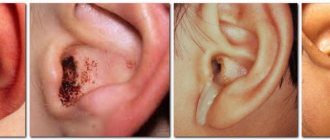Cough, headache, fever
Cough, headaches and fever are the initial signs of many diseases and especially acute respiratory viral infections.
A cough and fever indicate that an inflammatory process is developing in the body. And most often it affects the upper and lower respiratory tract. The cause of cough and headache may not be ARVI. For example, this could be an inflammatory process in the pharynx, nose, or adenoid growths.
Cough and fever, types and etiology of diseases with such manifestations are discussed further in the article.
Cough, headache and fever - what is the reason?
In reality, there are a huge number of factors causing cough, headaches and fever. Among the most common respiratory diseases it is worth noting:
All these diseases often cause elevated body temperature and may be accompanied by headaches.
Cough does not necessarily occur only with pathologies of the respiratory tract; it can also appear as a result of diseases of the heart and blood vessels or disruption of the digestive tract.
This type of cough can be caused by exposure of the lungs to cigarette smoke or by the many chemicals in the air in some areas.
In such a case, the cough is usually bothersome without any signs of a virus in the body - lethargy, fever, rhinitis.
You may be interested in: Dizziness when coughing.
Types of cough
Cough has its own classification:
- Acute cough, which lasts several weeks and chronic cough, which lasts more than three weeks, it begins several times a year and goes away without accompanying manifestations of infection.
- Dry non-productive cough (without sputum) and wet productive cough (with sputum).
Cough plays the role of a protective reflex, the purpose of which is to clean and free the airways from various irritants: dust masses, mucus, foreign objects, smoke, etc. A cough is called “productive” if secretions (sputum) are released and “non-productive” if there is no sputum.
It happens that a serious and prolonged cough does not burden a person. But, if the cough is of an infectious nature, then it may be accompanied by loss of appetite, difficulty breathing, often elevated temperature, and may also cause a headache.
Cough, headaches and fever are signals that unfavorable processes are occurring in the body that can be dangerous. Therefore, you should definitely visit the doctor.
The specialist will make an accurate diagnosis and determine the cause of these symptoms.
He can also refer the patient for additional diagnostics to specialized specialists, such as a cardiologist, ENT specialist, allergist and others.
Cough, fever and headaches - treatment of the disease
Cough therapy can be different, just like the cough itself. All drugs for the course can be divided into several categories:
- Mucolytics, which thin the mucus;
- Expectorants – production and evacuation of sputum;
- Antitussives.
For an adult, the therapist can choose one of the following mucolytics:
- Ambroxol;
- Lazolvan;
- Ambrohexal;
- Ambrobene.
Among the effective and inexpensive expectorant drugs it is worth noting:
- Mucoltin;
- Coldrex broncho;
- Pertussin;
- Acc;
- Bromhexine.
Antitussives are used only when there is a need to suppress the cough reflex - in cases of severe debilitating dry cough. This group of drugs is not permissible for use in self-medication, and in no case should it be combined with mucolytic drugs. This group includes drugs:
- Libexin;
- Faringomed;
- Codelac;
- Sinekod.
For headaches, any painkillers can be prescribed at the discretion of the attending physician:
- Citramon;
- Pentalgin;
- Solpadeine.
An antipyretic drug will help to overcome a high temperature, but it is worth remembering that in the case of a viral disease, you should forcibly lower the temperature only if the thermometer readings exceed 39 degrees.
At temperatures below this indicator, the body wages its own fight against viral agents, so you should not interfere with the immune system from performing its direct function.
The safest, most inexpensive and effective antipyretics for adults include:
- Paracetamol;
- Panadol;
- Nurofen.
Source: //nasmork.net/kashel-golovnaya-bol-temperatura/
Cough runny nose headache temperature 37 weakness
Such symptoms most often accompany a runny nose and chronic pharyngitis. In this case, cough and fever persist for a long time, which causes significant discomfort to the patient. Indeed, with this condition, malaise, constant fatigue, headaches, weakness, nasal discharge, etc. are also observed.
Features of this condition
Medical representatives call a body temperature of 37 degrees subfebrile.
It is quite difficult to establish the exact cause of this condition, so experts often prescribe many different additional tests and examinations to patients with such symptoms.
As a result, unclear and rare diagnoses may be made, which leads to lengthy, expensive, but not bringing any relief treatment.
It is necessary to understand that the causes of elevated temperature can be infectious and non-infectious.
The last group includes problems such as excess levels of certain hormones, vegetative-vascular dystonia, individual characteristics of a person and others. Of course, most often the reason lies in infectious diseases.
For example, this condition can occur with tuberculosis, prostatitis, rhinitis, sinusitis, bronchitis. sinusitis, tonsillitis and other pathologies.
Diseases that cause cough
If cough is noted. low-grade fever and sore throat, then it is these phenomena that become the catalyst for the disease. In other words, if these symptoms are eliminated, the disease will disappear.
Chronic pathologies of the ENT organs are more severe diseases.
They manifest themselves not only with fever and chronic rhinitis, but also with hearing problems, especially pronounced in children, tonsillitis, pharyngitis, and runny nose.
Such diseases can lead to the development of various complications, such as rheumatism, kidney inflammation, purulent pathologies of the throat, problems with the cardiovascular system and others.
It would seem that a constant runny nose and problems with cardiac activity are in no way interconnected. However, the human body is a very delicate thing in which all organs and systems are closely connected to each other. Therefore, if you have any health problems, it is better to consult a doctor immediately.
Causes
Other causes that can cause pain in the throat include injuries, foreign objects, fasting and poor diet, side effects of medications taken, discharge down the back of the throat due to adenoids, rhinitis or sinusitis, inhalation of polluted air or smoke, gastroesophageal reflux and others.
Inflammation of the mucous membranes can be caused by insufficient intake of vitamins.
The causes of fever, cough and sore throat can be problems with the gums and teeth, for example, periodontitis.
Neuralgia of the superior nerve of the larynx, as well as the glossopharyngeal nerve, and osteochondrosis of the neck can manifest as pain in the throat, accompanied by a cough.
The most common cause of pain in the throat is inflammation of the pharynx. It is also accompanied by cough and fever.
The second most common disease that causes such manifestations is tonsillitis. With it, there is a significant increase in temperature, enlargement of the submandibular lymph nodes, plaque on the tonsils, and pain when swallowing.
The cause of a sore throat can be infectious mononucleosis, as well as fungal infections. The latter appear in the throat area during tumor processes in the body, prolonged hormonal therapy, diabetes mellitus, and blood diseases.
Treatment and diagnosis
Diagnostic measures to determine the cause of a sore throat are carried out by an otolaryngologist. This complex includes an examination, blood test, and throat swabs.
Treatment, firstly, depends on the cause that caused this phenomenon. For pharyngitis, therapeutic measures include warming the feet in hot water with the addition of mustard, a gentle diet, warming compresses on the throat, and inhalations. reducing the number of cigarettes if you have this bad habit, drinking plenty of warm water, using special lozenges and sprays.
It is not worth using antibiotics for pharyngitis, because most often this disease is viral in nature.
Runny nose, cough and fever: causes and treatment
We all, some more often than others, suffer from such symptoms. Fever, snot, cough and sore throat interfere with our lives without asking, bringing discomfort and poor health.
Source: //novosibmemorial.ru/kashel-nasmork-golovnaja-bol-temperatura-37-slabost/
The relationship between headaches and cough
Cough itself represents a normal reaction of the body to external irritants: sharp and pungent odors, dusty rooms, viral infections and microorganisms, food particles and allergens.
Headache when coughing
Important! When coughing, several muscles contract at once, including the muscles of the neck and head - it is this muscle tension that can contribute to the appearance and intensification of headaches.
But a cough cannot be an independent cause of headache; If you have a headache when you cough, you should think about previous illnesses or consult a doctor for an examination and diagnosis of the cause of the headache.
It's time for colds. 10 most common colds and their self-diagnosis
Autumn, winter, cold, frost, wind - anyone can easily catch a cold or, worse, become seriously ill. According to statistics, almost every person catches an average of three colds a year. And in terms of the frequency of diseases, colds are generally in fourth place.
Often, with the first cold weather, a cough begins to appear, a headache, and weakness overcomes. Some people immediately begin to sound the alarm and call a doctor, while others, on the contrary, even feeling very unwell, chalk it up to simple fatigue, loss of strength, or overwork.
But it is quite difficult to determine the actual cause of your condition without having the appropriate knowledge.
In his everyday understanding, a person may not see the difference at all between, for example, ARVI and influenza. Very often, the flu is mistaken for a mild cold, and a cough and slight runny nose seem to be symptoms of a serious illness.
As a result, it turns out that when it is not necessary, a person begins to take antibiotics and other “heavy” drugs, and if there is a real need for them, he lets things take their course, being confident that “it’s okay - it will pass tomorrow.” But all this can not only be harmful, but even pose a danger to health and life.
This is, of course, most dangerous for infants and the elderly, as well as people suffering from heart and chronic pulmonary diseases such as bronchitis, asthma, emphysema, etc.
As usual, the cause for the development of serious viral diseases is ARVI - acute respiratory viral infections.
They are a group of diseases with similar symptoms, spread mainly by airborne droplets and affecting the respiratory system. It is problematic to name absolutely all diseases caused by ARVI, because
Scientists have identified over two hundred of them, but it is possible to list the most common ones. This is what we will do next, but first we will outline the main symptoms of ARVI :
- Weakness
- Muscle pain
- Labored breathing
- Stuffy nose (swelling of mucous membranes)
- Enlarged lymph nodes
- Temperature
- Headache
- Cough
- Sneezing
- A sore throat
- Fast fatiguability
- General malaise
If you notice several of these symptoms in yourself or someone close to you, you should pay serious attention to this and try to determine whether you are sick. You can also conduct an independent initial diagnosis of the suspected disease. The most common colds and their symptoms are listed below.
The most common colds and their symptoms
1
Flu is the most dangerous disease. It is capable of infecting a person in a matter of hours, as well as mutating and becoming more complicated, which can make fighting it a very difficult and difficult process.
It differs from other diseases, first of all, in the speed of damage to the body and its insidiousness - it can seem to suppress the development of some of its main symptoms, which is why it is not always possible to recognize it immediately.
Therefore, when the first signs of a cold appear, you should be very careful and take appropriate measures.
Flu symptoms: cough, runny nose, severe headaches, joint and muscle pain, weakness, fever (up to 39°C), sore throat, nasal congestion. Be careful: fever and joint pain may not appear immediately.
2
Rhinitis is a syndrome of inflammation of the nasal mucosa. It is usually caused by viral infections and microbes. To a greater extent, its development is promoted by gas and dust in the air, as well as hypothermia. By the way, rhinitis itself often serves as a symptom of diseases such as measles, diphtheria and influenza.
Symptoms of rhinitis: burning in the nose, runny nose, sneezing, nasal congestion, redness and swelling of the nasal mucosa, decreased sense of smell, low temperature (about 37°C). Please note that you may feel quite normal during rhinitis.
3
Laryngitis is an inflammation of the mucous membrane of the larynx. In the vast majority of cases, it is associated with colds and infectious diseases. Develops due to overheating, hypothermia, inhalation of dusty air, breathing through the mouth and overstrain of the larynx
Symptoms of laryngitis: rough cough, sore throat that gets worse during coughing, hoarseness, crusts and mucus in the larynx, swollen lymph nodes, changes in voice.
4
Bronchitis is the most common cold. It affects the human respiratory system. In this case, the inflammatory process itself “switches” directly to the bronchi. The main cause of bronchitis is considered to be a bacterial or viral infection.
Symptoms of bronchitis: dry or wet cough, accompanied by the release of mucous or mucopurulent sputum, difficulty breathing, wheezing during inhalation and exhalation, malaise, fever, which can be very difficult to “bring down.”
5
Sore throat is an infectious disease during which acute inflammation occurs in the pharynx area. Most often the palatine tonsils become inflamed. Various microorganisms cause sore throat: staphylococci, streptococci and others (less commonly).
Symptoms of tonsillitis: white or grayish films on the tonsils, enlarged lymph nodes, pain in the eyes, chills, cough, runny nose.
6
Phringitis is an inflammation of the lymphoid tissue and mucous membrane of the pharynx. Most often, pharyngitis occurs due to inhalation of cold, hot or polluted air, as well as due to any chemical irritations. In some cases, it can be triggered by infections and viruses.
Symptoms of pharyngitis: cough, dryness and sore throat, aggravated by coughing, pain during swallowing, coughing, mucous and mucopurulent discharge in the pharynx and swelling of its lateral folds.
7
Tracheitis is, simply put, inflammation of the trachea. Despite the fact that the trachea is part of the lower respiratory tract, tracheitis is classified as an upper disease. As an independent disease, it is quite rare and most often accompanies bronchitis, laryngitis, pharyngitis and rhinitis, and occurs as a consequence of them.
Symptoms of tracheitis: painful dry cough (over time - with sputum), a burning sensation and rawness in the sternum area, intensifying during coughing, heavy breathing, wheezing, mucous and mucopurulent discharge.
8
Bronchiolitis is an inflammation of the bronchioles, the terminal branches of the bronchial tree that pass into the lungs. Most often, bronchiolitis occurs due to a respiratory tract infection, as well as due to inhalation of very hot or very cold air.
Symptoms of bronchiolitis: rapid breathing with difficulty exhaling (even with mild physical exertion), painful cough with difficult sputum, hoarseness, chest pain, pale or bluish skin.
9
Pneumonia (also known as pneumonia) is an acute infectious disease of the lungs that affects the lung formations - the alveoli. Often develops together with other diseases, such as tonsillitis, bronchitis, etc. Its main pathogens are microorganisms. It can develop into an acute form and is difficult to treat.
Symptoms of pneumonia: general malaise and weakness, pain in muscles and joints, cough with phlegm, wheezing during breathing, high fever, trembling voice.
10
Herpes is a viral disease with a rash of vesicular formations on the skin and mucous membranes. There are several types of herpes, but the most common is herpes simplex. It mainly affects the skin of the lips. And the reasons for its appearance are hypothermia and overheating, as well as weakened immunity.
Symptoms of herpes: blisters with clear liquid on the affected area of the body (in this case, on the lips). Often, before the onset of herpes, a burning sensation of the skin and itching may be felt at the site of its future appearance; there may be malaise and chills.
Guided by this information, you can always independently carry out a preliminary diagnosis of a cold and have time to take some action to eliminate it. But, in any case, you need to consult a doctor, because only he can make a diagnosis as accurately as possible and prescribe appropriate treatment.
However, the best option for maintaining your health will not be good and professional treatment of diseases, but their timely prevention and a healthy lifestyle. Remember this and you can be one of the completely healthy people.
Source: //4brain.ru/blog/%D0%BF%D0%BE%D1%80%D0%B0-%D0%BF%D1%80%D0%BE%D1%81%D1%82%D1% 83%D0%B4/
Temperature 37.5°, cough, runny nose, headache: causes, treatment
When a person begins to feel a number of symptoms (temperature 37.5°, cough, runny nose, headache), it is necessary to take immediate action. Such signs can be the first signal of a serious and serious illness.
What does it mean if a child has a fever with a cough, runny nose and headache?
A temperature of 37° is the initial stage of many diseases. A further increase in temperature, accompanied by malaise, indicates progression of the disease. The child’s body begins to protect itself from pathogenic microorganisms that cause the disease.
If a child has symptoms such as a temperature of 37.5°, cough, runny nose, headache, it is necessary to show him to a doctor. These signs clearly indicate an acute respiratory viral infection. However, to confirm the diagnosis and prescribe appropriate therapy, consultation with a specialist is necessary.
ARVI is characterized by a number of additional symptoms:
- chills;
- weakness;
- a sore throat;
- dizziness;
- lack of appetite.
It is important to pay attention to the shape of the cough. Depending on whether it is dry or wet, the type of disease is determined.
Why is a temperature of 37.5° with a runny nose and headache dangerous in a child?
Temperature 37.5°, cough, runny nose, headache - this is not only a set of symptoms that are most characteristic of ARVI. A more dangerous disease, often found in children, has the same symptoms. We are talking about polio. If a child complains of abdominal pain or diarrhea, it is necessary to immediately contact a medical facility for diagnosis.
Self-medication is strictly unacceptable. Many mothers, when their child develops a runny nose, cough and fever, begin to take a set of measures against colds. Home treatment does not have the desired effect, and meanwhile polio progresses. This threatens serious health problems. Poliomyelitis can lead to paralysis, atrophy of the limbs, and curvature of the spine.
How to treat a pathological condition in a child?
So, how to treat a child if he has a fever with a headache, cough and runny nose? First of all, it is necessary to observe bed rest. If the child is a schoolchild, you need to temporarily stop attending classes and take sick leave. You should also refrain from walking outside, but at the same time ventilate the sick child’s room daily.
It is extremely important to make the patient drink plenty of fluids. This can be not only purified water, but also warm tea, juices and fruit drinks. It is useful to drink rosehip infusion daily. It will not only improve your general condition, but also strengthen your immune system. The total daily volume of fluid required by a sick child is at least 2 liters.
It is strongly recommended not to give medications to your child without a doctor’s prescription. This is especially true for antibiotics.
Experts do not advise lowering the temperature at 37.5°C. If there is a sharp jump in temperature exceeding 38°, you can use vinegar compresses. To do this, mix table vinegar with a small amount of water.
Moisten a handkerchief generously in the solution, squeeze lightly and cover the child’s forehead with it. Rubbing with a vinegar solution will help cope with the increased temperature. To do this, you need to soak a handkerchief or towel in the solution and wipe the child’s arms, legs, and torso.
Do not forget that vinegar compresses help cope not only with fever, but also with headaches.
An adult has a fever, headache, cough and runny nose. what caused it?
If an adult has a fever accompanied by a cough, this is the main sign of an inflammatory process. It can be localized in both the upper and lower respiratory tract. If you feel unwell, you need to pay attention to the type of cough.
- Dry cough . A painful dry cough indicates the presence of mucus accumulated in the respiratory tract. However, an exhausted, weakened body is not able to eliminate stagnation on its own. In this case, the doctor’s task is to use medications to transform a dry cough into a wet one.
- Moist cough . It is considered a milder form of cough because the body clears itself by coughing up phlegm. If a wet cough occurs against a background of a temperature of 37.5°, this means that the exudative stage of the inflammatory process is occurring.
If a wet cough is accompanied by a runny nose, we are talking about an acute inflammatory process. With this diagnosis, the patient also feels a severe headache, weakness, fever, and sore throat.
The danger of an acute inflammatory process is that the disease can become chronic.
If the temperature remains at 37.5° for 7-8 days, you should seek medical help.
How to treat a pathological condition in an adult?
There are a number of popular and inexpensive medicines that can improve the patient’s well-being. However, it is strongly recommended not to take any medications without consulting a doctor!
How to treat a patient:
- Aspirin . The most popular medicine that helps relieve inflammation, eliminate headaches, and improve overall well-being. At the moment, Aspirin is quite difficult to find in pharmacy chains. In this case, it can be replaced with Acetylsalicylic acid, which is an absolute analogue of Aspirin.
- Paracetamol . The most popular medicine with which you can quickly bring down a rising temperature. Paracetamol also has an analgesic effect. For a faster therapeutic effect, doctors recommend crushing the tablet and drinking plenty of water.
- Ibuprofen . A powerful modern remedy that has an anti-inflammatory effect. Indispensable for acute inflammation of the respiratory tract. It also helps eliminate fever and headache.
As for antibiotics, taking them is strictly prohibited without a doctor’s prescription.
In addition to taking medications, the patient must remain in bed and drink plenty of fluids (at least 3 liters per day).
If you have a runny nose, cough, sometimes a headache, but no fever, how to treat it?
If you have a runny nose, cough and headache, but no fever, many people will be interested in knowing how to treat such symptoms. The initial stage of a cold or ARVI begins this way.
The main thing is to suspect the development of the disease in time and begin to eliminate it.
Sometimes a cold occurs without a rise in temperature, so in this case it is important to get rid of the main symptoms, which significantly complicate life.
What to do first?
If there is no fever, but there is weakness, and also a cough, runny nose and headache, how to treat such manifestations? To begin with, you should reduce physical activity and rest as much as possible. If you experience similar symptoms on your legs, the treatment will take much longer.
You can prepare a healing tea that will boost your immunity and stop the development of the disease. To do this you will need ginger root, lemon and a little honey. The first 2 ingredients should be poured with boiling water and allowed to brew for about 30 minutes.
Then add some honey to the kettle. The drink should be warm, but not scalding. You should not overdo it with ginger so that the product is not too spicy.
This drink will help get rid of nasal congestion, calm a cough and eliminate headaches.
To reduce the severity of a runny nose, it is recommended to instill saline solution. They should additionally rinse their sinuses at least 3 times a day. You can purchase seawater solutions, such as Aquamaris.
If nasal congestion is severe, it is recommended to use vasoconstrictor sprays, which will reduce the severity of swelling and make breathing easier. These include: Nazivin, Tizin, Nazol, etc. A severe runny nose can also be eliminated with the help of Protorgol and Vibrocil, which help where other means are useless.
For long-term rhinitis, which has been present for more than a week, it is recommended to change the drops every 4-5 days so as not to provoke addiction.
To relieve headaches, you can use Solpadeine, Tempalgin and Nurofen. If you stay in bed, these symptoms will go away very soon.
Cough requires serious treatment, depending on its form. A universal remedy is the drug Rengalin, which is used in the presence of any type of cough.
If sputum is produced, then Mucoltin, Hydelix and other means are indicated to speed up its discharge.
What else will help with these symptoms?
If the headache is constant, it is recommended to additionally measure your blood pressure. If the levels are low, you should take a drug with caffeine, for example Solpadeine or Citramon.
If your blood pressure is high, it is better to use modern antihypertensive drugs. Echinacea tincture will help you quickly get rid of unpleasant symptoms.
It strengthens the immune system and speeds up the healing process.
To relieve a runny nose, you can use essential oils of mint, pine and eucalyptus. Dissolve the listed ingredients drop by drop in 1 tbsp. l. olive oil or baby cream and apply to the temples and sinuses. This simple remedy will help relieve congestion, soften the upper respiratory tract and reduce headaches.
To relieve cough and nasal congestion, it is good to use special inhalations with a nebulizer. If such a device is not at hand, then you can use improvised means. For colds, inhalation based on chamomile, sage and mint will help.
To do this, you will need dry raw materials of the listed herbs. You need to place them in a saucepan, 1 tsp each. and pour 1 liter of boiling water. Boil for a couple of minutes and turn off the burner.
Then take a towel and, covering your head, inhale the vapors alternately through your nose and mouth.
If you have a headache for a long time, you can use St. John's wort for treatment. It should be brewed with oregano and drunk instead of tea. This solution will help you get rid of unpleasant symptoms faster.










